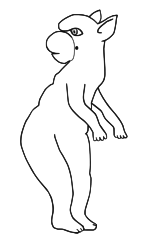Gnome of Girona
 | |
| Other name(s) | Gnomo de Gerona, Duende de Gerona |
|---|---|
| Country | Spain |
| Habitat | Countryside |
The Gnomo de Girona Lepugnomus gerundensis (Gnome of Girona) is the name given to the remains of an animal or a fetus found near Girona, Catalonia (Spain), in September 1989 that aroused some attention from the Spanish media, especially some TV programs specialized in parapsychology and the paranormal such as En los límites de la realidad and Otra dimensión.
Morphology
The body was bluish, devoid of hair, with some little spots mainly in neck and face. Its total length was approximately 12 centimetres (4.7 in). It showed a protuberance in the forehead area, elongated ears, reddish eyes and a snout similar to that of rodents. Its fingers showed interdigital membranes.
Discovery
According to the original version showed on TV, the being had been captured by some campers about 11 kilometers from Girona, in the route from the villages of Banyoles to Olot. They were near a forest when one of them heard some noises similar to low volume moans. When he looked in the direction from where the noises were coming he spotted the being, that tried to escape moving fast from them. The being emitted "a kind of squeak similar to an old man's laughter". The campers managed to capture the being by throwing a blanket over it.
The being then remained alive for approximately 24 hours after its capture, although other versions of the story extend this time to four days. It refused all food offered to it although according to its captors showed some degree of intelligence. After its death, the Spanish parapsychologist Ángel Gordon got the body and preserved it in a jar with formol.
Explanations
After examination of the available pictures of the preserved body, the American investigator John Altshuler and Spanish doctor Luís Linares concluded that it was not the normal fetus of any known animal. Doctor Linares declared two possibilities:
"The first option is that it is a monstruous being, that is to say a teratorogical case in which tissues like limbs, organs, etc. develop but in an abnormal way. It can also be the finding of a primitive being that has been conserved in a cold area, like snow or a glacier, where the tissues would have remained preserved. In this case, we would be facing an animal unknown to modern science"
Hoax
On the other hand, investigator Pedro Palao and biologists from the Barcelona Zoo stated that the remains could be from the fetus of some ruminant, probably a calf in its third month of gestation, which showed evidence of the whole issue being a fake.
Later investigator Francisco Contreras discovered that the campers identified in the TV programs as Mario Añaños and Juan Pujals, never existed, and in turn the animal was originally found dead by Manuel Tello, inhabitant of Girona, who preserved it in a jar and made some pictures of it. The connection between the pictures and how they reached the media is obscure, qualifying the whole story as a hoax of dubious authority.
External links
- Cochihumanos, Marraniños y Duendes at the Wayback Machine (archived January 15, 2007), in Spanish with pictures of the being along with some artistic interpretations.
- Yo he visto un gnomo at the Wayback Machine (archived September 28, 2007), in Spanish.
- El polémico gnomo de Girona at the Wayback Machine (archived April 13, 2012), in Spanish.